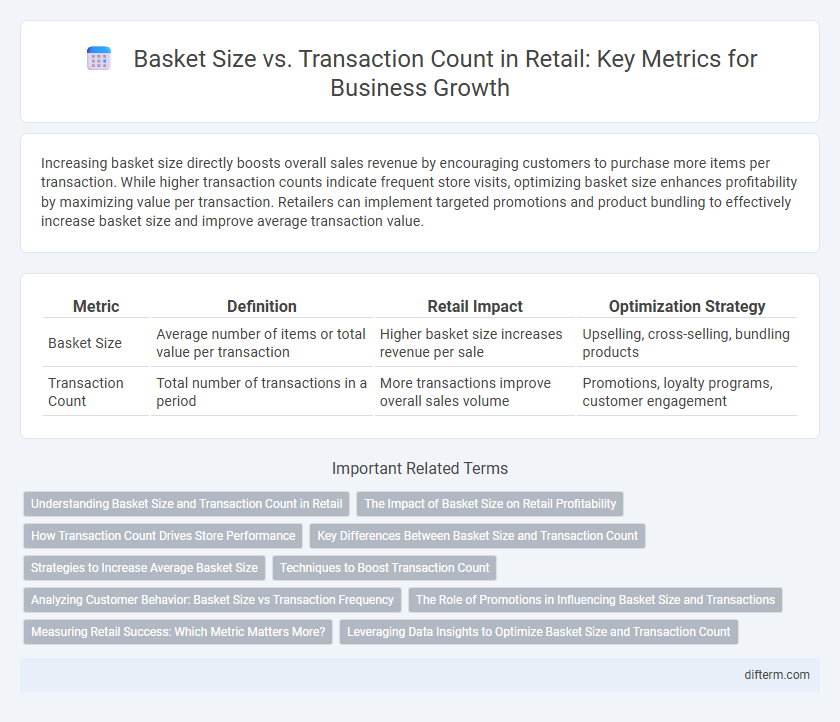Increasing basket size directly boosts overall sales revenue by encouraging customers to purchase more items per transaction. While higher transaction counts indicate frequent store visits, optimizing basket size enhances profitability by maximizing value per transaction. Retailers can implement targeted promotions and product bundling to effectively increase basket size and improve average transaction value.
Table of Comparison
| Metric | Definition | Retail Impact | Optimization Strategy |
|---|---|---|---|
| Basket Size | Average number of items or total value per transaction | Higher basket size increases revenue per sale | Upselling, cross-selling, bundling products |
| Transaction Count | Total number of transactions in a period | More transactions improve overall sales volume | Promotions, loyalty programs, customer engagement |
Understanding Basket Size and Transaction Count in Retail
Basket size in retail refers to the average number of items or total value purchased per transaction, serving as a critical metric for sales performance analysis. Transaction count measures the total number of individual purchases within a specific period, reflecting customer footfall and shopping frequency. Analyzing the relationship between basket size and transaction count helps retailers optimize inventory, tailor marketing strategies, and maximize overall revenue.
The Impact of Basket Size on Retail Profitability
Increasing basket size directly boosts retail profitability by raising the average transaction value and maximizing revenue per customer visit. Larger basket sizes often reduce relative transaction costs, improving overall margins and enabling better inventory turnover. Retailers focusing on strategies to increase basket size, such as cross-selling and personalized promotions, experience higher profit growth compared to solely increasing transaction count.
How Transaction Count Drives Store Performance
Transaction count directly influences retail store performance by increasing foot traffic and sales opportunities, leading to higher overall revenue. Stores with higher transaction counts often experience improved inventory turnover rates and enhanced customer engagement. Optimizing checkout processes and promotional strategies can effectively boost transaction frequency, driving sustained growth.
Key Differences Between Basket Size and Transaction Count
Basket size measures the average number of items or total value per customer purchase, reflecting individual buying behavior, while transaction count quantifies the total number of purchases made within a specific period, indicating overall store activity. Basket size directly impacts revenue per sale and helps identify customer spending patterns, whereas transaction count is crucial for understanding foot traffic and sales frequency. Retailers analyze both metrics to optimize inventory management, marketing strategies, and store layout to enhance sales performance.
Strategies to Increase Average Basket Size
Increasing average basket size in retail can be achieved through personalized product recommendations that leverage customer purchase history and AI-driven insights. Implementing targeted promotions such as bundling complementary items or offering tiered discounts encourages customers to add more products per transaction. Enhancing the in-store experience with visually appealing displays and easy-to-navigate layouts also influences shoppers to increase their purchase volume.
Techniques to Boost Transaction Count
Increasing transaction count in retail can be achieved through targeted promotions like buy-one-get-one offers and loyalty programs that encourage frequent visits. Implementing mobile payment options and streamlined checkout processes reduces friction, making customers more likely to complete purchases. Employing personalized marketing campaigns based on customer behavior data enhances engagement and drives repeat transactions.
Analyzing Customer Behavior: Basket Size vs Transaction Frequency
Analyzing customer behavior through basket size versus transaction frequency reveals critical insights for retail optimization. Larger basket sizes often indicate higher-value shopping trips, while increased transaction counts reflect frequent store visits, both influencing customer lifetime value. Retailers can tailor promotions and inventory strategies by balancing the trade-off between encouraging higher basket sizes and fostering transaction frequency to maximize revenue.
The Role of Promotions in Influencing Basket Size and Transactions
Promotions significantly boost basket size by encouraging customers to purchase more items per transaction, often through discounts, bundle offers, or loyalty rewards. While transaction count may increase during promotional periods, the primary impact is on the average basket value as shoppers take advantage of deals to maximize savings. Retailers strategically design promotions to balance driving higher transaction counts with increasing basket size, optimizing overall sales performance.
Measuring Retail Success: Which Metric Matters More?
Basket size reveals average spending per customer, directly impacting revenue growth and profitability in retail environments. Transaction count indicates customer frequency and store traffic, essential for understanding market penetration and consumer engagement. Comparing both metrics highlights the balance between attracting frequent shoppers and encouraging higher spending per visit, guiding retailers to tailor strategies for maximizing overall sales performance.
Leveraging Data Insights to Optimize Basket Size and Transaction Count
Leveraging data insights allows retailers to analyze patterns in basket size and transaction count, identifying opportunities to increase average order value and frequency of purchases. By segmenting customers and personalizing promotions based on purchase behavior, businesses can strategically encourage higher basket sizes while boosting transaction counts. Advanced analytics enable precise inventory management and targeted marketing campaigns, optimizing overall sales performance.
Basket size vs Transaction count Infographic

 difterm.com
difterm.com